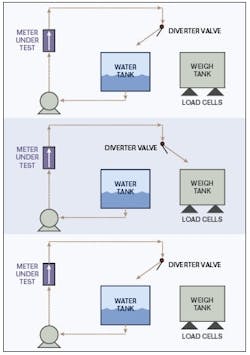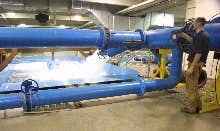However, expanded diagnostics applicable to some flowmeter technologies are becoming available to check more of the status relating to the primary element. In some flowmeters, primary element status is used to infer that flowmeter calibration hasnt shifted. This inference isnt a substitute for checking calibration, but when properly designed and interpreted, this status information does increase the probability that the flowmeter is operating properly and that the flowmeter calibration hasnt shifted.A brief review of calibration here may help clarify implications of information in the previous paragraph. Flowmeters can be calibrated by comparing measurements of the same fluid through a flow laboratory calibration standard and the meter under test (MUT). This can be done by circulating the liquid (See Figure 1, top), diverting the liquid to a weigh tank (middle), and then circulating again (bottom). By comparing measurements from the standard and the MUT (while diverting), the MUT can be adjusted (calibrated) to provide measurements that mimic the standard. FIGURE 1: PRIMARY FLOWMETER LABORATORY
Calibrating flowmeters can be done by comparing measurements of the same fluid through a flow laboratory calibration standard and the "meter under test" (MUT). This is accomplished by first circulating the liquid (top), diverting the liquid to a weigh tank (middle), and then circulating again (bottom). By comparing measurements from the standard and the MUT (while diverting), the MUT can be adjusted (calibrated) to provide measurements that mimic the standard.
Calibration also can be performed by comparing measurements from the MUT with a flow laboratory with a master flowmeter in series with the MUT. In contrast, in-situ calibration is performed on the installed flowmeter in the field, where its measurements are compared with a standard such as a portable prover. Note that these are wet calibrations because the actual fluid flows through the MUT and the standard. Alternatively, dry calibrations are often used to infer that the flowmeter is calibrated. For example, differential pressure flow transmitters are often wet calibrated using a pressure source; however, its orifice plate flowmeter primary may be dry calibrated by measuring its diameter and visually inspecting it for damage. Many times, it is not examined at all, so it remains uncalibrated and unchecked. On the other hand, using a calibrator to verify operation of a magnetic flowmeter performs a wet calibration on the transmitter, but doesnt check calibration of the magnetic flowmeter primary at all. This procedure is commonly called a calibration. Note that its entirely possible that the magnetic flowmeter primary could be damaged or even non-functional before, during, and after this type of calibration. Fewer Calibrations = Less Costs
Consequently, expanded diagnostics for the flowmeter primary are not a substitute for a wet calibration. However, performing expanded diagnostics does increase the probability that the flowmeter primary is still operational and functioning properly. Instruments with a higher probability of proper operation need not be calibrated as often as instruments subject to frequent calibration shifts or failure. Therefore, adding expanded diagnostics to a flow measurement system can increase the time between calibrations and can reduce the overall cost of calibrating the flowmeter. Flowmeters that dont have expanded diagnostics generally require some human intervention to locate and diagnose problems. In many plants, the expertise needed to diagnose the problem may not be readily available. Expanded diagnostics can reduce labor costs by more clearly identifying the problem quickly without human intervention. In some cases, problems can be detected and identified, while the problem may still be intermittent and occur well before the process is affected. This can improve process availability and save significant amounts of money in some applications. Despite limitations, some flowmeter suppliers are embedding diagnostics that verify the integrity of the flowmeter primary. In general, certain parameters associated with the flowmeter primary are measured in the field and compared with measurements previously made at the factory. As long as the difference between the factory values and field measurements remain within tolerances, the calibration of the flowmeter primary is presumed not to have shifted. Some expanded diagnostics are continuously monitored, while others are performed periodically.
An operator monitors the flow into the 300,000 lb. capacity weight and volumetric calibration water tank at Utah State University's Hydraulics Lab in Logan, Utah.
Despite its limitations, expanded diagnostic coverage is an in-situ flowmeter verification tool that can improve flowmeter availability and extend intervals between routine calibrations and/or verifications. For example, Micro Motion recently announced the availability of expanded diagnostic coverage for its Coriolis mass flowmeters. It found that verifying the density measurement by periodically filling the flowmeter with known fluids (typically water and air) implies that the flowmeter calibration hasnt changed due to product build-up or corrosion. This is an example of a periodic diagnostic that can reduce calibration costs by increasing the time between routine reference device verifications. Franki Parson, industry manager of life sciences at Micro Motion, says that, Many GMP-validated pharmaceutical manufacturing facilities must routinely verify field instrumentation to demonstrate process consistency. The ability to verify consistent performance, without external calibration laboratories or reference flowmeters, can reduce production interruptions, and can extend intervals between routine verifications. This generally requires less human intervention and can reduce labor costs. Joseph LaFauci. associate director of automation technology at Merck & Co., adds that, The use of expanded diagnostics should be considered to reduce costs associated with maintaining flowmeter performance. He notes that hard data supporting the cost savings generally isnt available because flowmeters with expanded diagnostics have been on the market for a relatively short time.Joseph adds the benefits of expanded diagnostics are amplified when used with fieldbus technology that allows faster and more accurate troubleshooting. However, the benefit received from expanded diagnostics depends upon the criticality of the instrument in the process, he says. For example, in critical applications, safety can be improved when transmitter diagnostic status is used to override potentially dangerous, fast-acting process events. Using advanced diagnostics coupled with control system interlocks provides predictable results and safeguards correct operator action. Some flowmeter suppliers, such as ABB, Krohne and Siemens, can provide portable equipment to periodically check their magnetic flowmeter primaries for insulation resistance and other internal electrical parameters that are indicative of flowmeter primary problems. These are also periodic diagnostics that can reduce the cost of calibrations. Meanwhile, Joe Incontri, sales and marketing director at Krohne, reports his company offers a magnetic flowmeter transmitter that can continuously perform expanded diagnostics on the flowmeter primary, such as checking for gas bubbles, electrode corrosion, low conductivity, liner damage, electrode fouling, external magnetic fields, partially full conditions, flow profile changes, and conductivity changes. Incontri adds that Krohne also offers a separate, portable, handheld device that performs similar functions. An advantage of this approach is that the portable can be brought into a laboratory and calibrated, so it will be traceable to an external standard. Availability Increases Safety
One measurement specialist at a multinational chemical company points out that the value of expanded diagnostics is more evident in Europe, where proof testing of Safety Instrumented Systems (SIS) has been common for more than a decade. Standards require proof testing of failure modes not covered by diagnostics. Therefore, high diagnostic coverage could reduce testing costs because fewer failure modes need to be tested. In addition, allowances for diagnostics might increase process availability in some applications. For example, a 1oo2D (1 out of 2 redundant decision, digital) installation using transmitters with expanded diagnostics might be able to replace a 1oo2 installation that uses conventional transmitters. Compared to the 1oo2, the 1oo2D would tend to reduce the number of false trips. Another part of improving flowmeter performance is increasing the time that the flowmeter produces good measurements by pinpointing the cause of a problem and/or detecting the problem before it affects the flow measurement and the process. This is especially important when the flowmeter is difficult to access, according to Edgar Fajardo, senior instrument and electrical engineer at BASF in the Netherlands. Edgar works with instruments that have been installed for about a year on an unmanned platform that communicates to land via a fiber-optic link. Expanded diagnostics can help reduce costly helicopter trips to the platform by allowing some problems to be fixed from his office on land. If a trip becomes necessary, remote expanded diagnostics can help the technician select and bring the proper equipment and parts. Flowmeters with expanded diagnostics have only been installed recently. The prospects for this technology look promising, but time will tell whether the use of expanded technology will take plant operation to a new level.
| About the Author |

Leaders relevant to this article:







